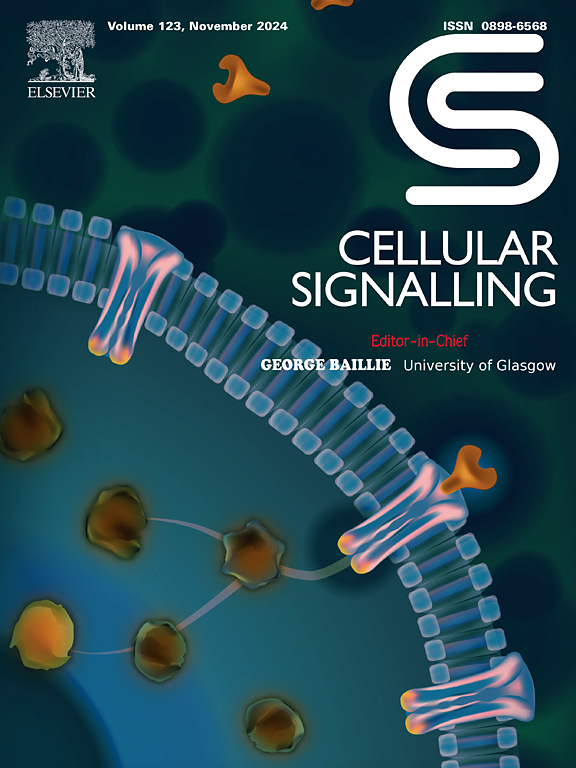在慢性收缩性损伤中,RIN1通过Nrf2/HO-1通路调节铁下沉和伤害性知觉。
IF 4.4
2区 生物学
Q2 CELL BIOLOGY
引用次数: 0
摘要
神经性疼痛(NP)几十年来一直是临床研究的主要焦点。本研究探讨RAS-和rab -相互作用蛋白1 (RIN1)在NP调控中的作用,并探讨核因子-2红细胞因子-2 (Nrf2)和血红素加氧酶1 (HO-1)通路在NP调控中的作用。建立大鼠CCI模型。机械和热过敏的存在,以及自发的疼痛行为,证实了成功的建模。鞘内注射靶向RIN1的AAV9-shRNA可减轻痛觉,降低L4-L6脊髓的小胶质细胞活化,降低c-Fos、GFAP和IBA-1的表达水平。此外,与神经过敏相关的NMDAR、PKC、Src酶的水平被RIN1沉默抑制。发现RIN1与Nrf2蛋白相互作用,抑制其核易位和转录激活。RIN1敲低激活Nrf2/HO-1通路,降低脊髓氧化应激和ROS水平,同时增加Nrf2靶基因的表达,包括Nqo1、Gclc和Gclm,这些基因在细胞抗氧化防御中起关键作用。此外,在RIN1敲除的大鼠中,以线粒体损伤和Fe2+水平升高为特征的铁上吊现象减少。用Nrf2或HO-1激活剂治疗可改善疼痛敏感性并减轻炎症,而抑制Nrf2活性会减弱RIN1沉默的保护作用。在体外,RIN1沉默降低lps处理的小鼠BV2小胶质细胞的活化,导致促炎细胞因子(IL-6、TNFα和IL-1β)分泌减少,减少小胶质细胞凋亡,降低BV2细胞对共培养神经元的细胞毒性。这些作用是由Nrf2途径介导的,因为Nrf2拮抗逆转了RIN1敲低的作用。这些发现表明,RIN1通过抑制Nrf2/HO-1通路,影响神经炎症和铁下沉,在脊髓超敏反应和疼痛感知中起关键作用。靶向RIN1可能为治疗NP和神经炎症提供潜在的治疗策略。本文章由计算机程序翻译,如有差异,请以英文原文为准。

RIN1 regulates ferroptosis and nociceptive perception via the Nrf2/HO-1 pathway in chronic constriction injury
Neuropathic pain (NP) has been a major focus of clinical research for decades. This study investigates the function of RAS- and RAB-interacting protein 1 (RIN1) in modulating NP and explore the involvement of the nuclear factor-2 erythroid factor-2 (Nrf2) and heme oxygenase 1 (HO-1) pathway in this context. A rat model of CCI was generated. The presence of mechanical and thermal hypersensitivity, as well as spontaneous pain behaviors, confirmed the successful modeling. Intrathecal injection of AAV9-shRNA targeting RIN1 attenuated nociception, reduced microglial activation in the L4-L6 spinal cord, and decreased the expression levels of c-Fos, GFAP, and IBA-1. Furthermore, the levels of NMDAR, PKC, Src, enzymes linked to neural hypersensitivity, was inhibited by RIN1 silencing. RIN1 was found to interact to Nrf2 protein, inhibiting its nuclear translocation and transcriptional activation. The RIN1 knockdown activated the Nrf2/HO-1 pathway, reducing oxidative stress and ROS levels in the spinal cord, while increasing the expression of Nrf2-target genes, including Nqo1, Gclc, and Gclm, which are key players in cellular antioxidant defense. Additionally, ferroptosis, characterized by mitochondrial damage and elevated Fe2+ levels, was reduced in RIN1 knockdown rats. Treatment with Nrf2 or HO-1 activators improved pain sensitivity and reduced inflammation, while inhibition of Nrf2 activity attenuated the protective effects of RIN1 silencing. In vitro, RIN1 silencing reduced activation LPS-treated of mouse BV2 microglial cells, leading to a decrease in the secretion of pro-inflammatory cytokines (IL-6, TNFα, and IL-1β), reduced microglial ferroptosis, and decreased the cytotoxicity of BV2 cells to co-cultured neurons. These effects were mediated by the Nrf2 pathway, as Nrf2 antagonism reversed the effects of RIN1 knockdown. These findings suggest that RIN1 plays a critical role in spinal cord hypersensitivity and pain perception by inhibiting the Nrf2/HO-1 pathway, influencing neuroinflammation and ferroptosis. Targeting RIN1 could provide a potential therapeutic strategy for managing NP and neuroinflammation.
求助全文
通过发布文献求助,成功后即可免费获取论文全文。
去求助
来源期刊

Cellular signalling
生物-细胞生物学
CiteScore
8.40
自引率
0.00%
发文量
250
审稿时长
27 days
期刊介绍:
Cellular Signalling publishes original research describing fundamental and clinical findings on the mechanisms, actions and structural components of cellular signalling systems in vitro and in vivo.
Cellular Signalling aims at full length research papers defining signalling systems ranging from microorganisms to cells, tissues and higher organisms.
 求助内容:
求助内容: 应助结果提醒方式:
应助结果提醒方式:


